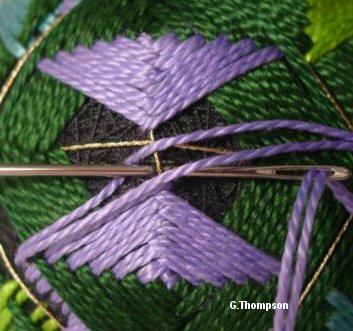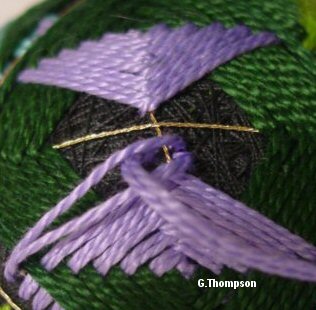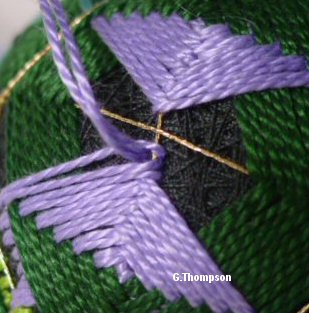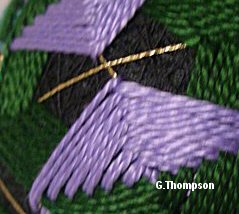Stitching with Double Thread - "Railroading"
Using double thread means that rather than one strand creating the stitch, there are two, handled as one. This technique may be used for several reasons; sometimes it's just plain faster if there is a large area to be covered in one color, especially on a larger mari. However, it more often it is called for to create specific pattern effects or emphasis.
Either way, for it to be truly effective both threads need to be kept from crossing and twisting as you lay them down and stitch. In general, handling multiple strands properly is called "stripping and laying" - but when it refers to using 2 strands, the nickname has become "railroading" (for obvious reasons). Often the needle or a laying tool is used to straighten and align the multiple threads as they are laid down and stitched into place, but railroading is a wonderful method to use for 2-strand work that makes it much easier.
The actual "double thread" itself can be prepared in different ways. Ideally, two lengths of thread are cut, laid next to each other, and handled as one thread, inserting both into the eye of the needle when threading it. Alternatively, one longer length may be cut, the single end threaded into the needle, and then the thread is "doubled" - folded in half so the two ends are together, and the "loop" that is formed in the middle of the thread when folded in half is in the eye of the needle. Choose the one that works best for you (I prefer the first, since it's much easier to start, and correct, stitching while in progress).
When taking a stitch, let the threads lay across where you intend to take the stitch and hold them with your thumb; then ease the point of the needle between the two threads and into the spot where the stitch is to be. As you pull the threads through, they will flip evenly without twists. Another version of this tip is to lay the threads, take the stitch and bring your needle up through the two threads as shown below:
 Lay threads in place to stitch; here it is left to right. Needle is inserted right to left for stitch. |
 Pull the needle
& thread through. Needle & working threads are between
the double strand. Pull the needle
& thread through. Needle & working threads are between
the double strand. |
 Finish and snug up the stitch; threads should lie flat and smooth. Adjust if needed. |
 Completed stitches, with all threads laying parallel, no twists. |
This
is a TemariKai.com Printable Page; © 2014, all rights reserved.
Right click to print one copy for personal use.
Last updated 1/2014 © 1998 - 2014 TemariKai.com, G. Thompson/PuffinStuff, Inc.
